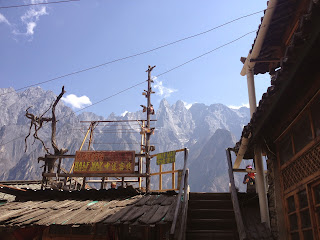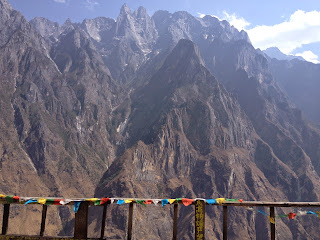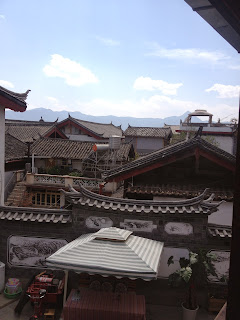The Tiger Leaping Gorge area is one of myths and legends. The Yangtzhe River bisects Jade Snow Mountain and Haba Snow Mountain to form the crashing gorge below. Above, miles of hiking trails give walkers vertiginous panoramic views of the sublime landscape. Words do not do this place justice.
Sadly, soon pictures won't either. The Chinese wilderness is quickly being carved out in the name of progress. One dam already worked on changing the flow of the crashing water and as we hiked, we could see progress on a second dam not far away. First glimpses however, did not disappoint:
We started our hike after a bus ride from Lijiang. After finding the ticket office at Qiaotou, my hardy group of fairly out of shape and always hungry students made our way to the 'trailhead' following our trusty 'map.' It turns out this 'map' didn't account for any of the construction or changes to the landscape that had recently happened.
Up, up, up we went. Eventually, the mountains emerged and did not disappoint.
After passing men with donkeys, a man and his 'shop' selling Pepsi, sabres and weed, we reached the delightfully labelled first major viewpoint. The walk there took hours longer than my students had planned but food breaks, foot pain breaks, breaks added up.Which is how we found ourselves spending the night at the Naxi Guest House, a stunning series of traditional wooden houses with an equally stunning view:
We ate dinner in the courtyard before retiring to our unheated rooms for the night. At nearly 1800 metres, the air became more than bitingly cold.
We woke up the next morning ready to tackle the aptly named 28 bends, a series of 28 uphill switchbacks leading to our next viewpoint.
Shortly thereafter, we had a little rest break at the Tea Horse Guesthouse before making our way to dizzying heights:
Our final guesthouse, the Half Way Guest House, yielded our final viewing points before we reached the truly terrifying portion of the trail.
A three-foot wide path separated us from the 1800 metre drop below. Mountain goats trekked up the side highlighting their death defying skill and I had several moments of panic. Having never been afraid of heights before, it was an unnerving feeling. Unfortunately for two of my students who had a legitimate fear of heights, the walk and mini-rock scramble induced near panic attack-like symptoms. They stopped, cried, breathed, stopped again. Progress was excruciatingly slow.
And still the view continued to defy logic. We eventually made our way to the end of the trail where I dropped my students off at Tina's Guest House before making my way to the staff section at Woody's Guest House. Even on lower ground, the whole valley presented itself in its splendour:



























































